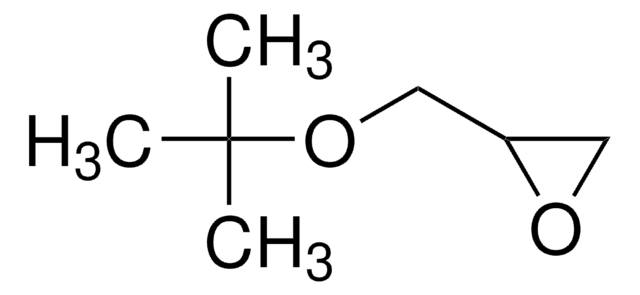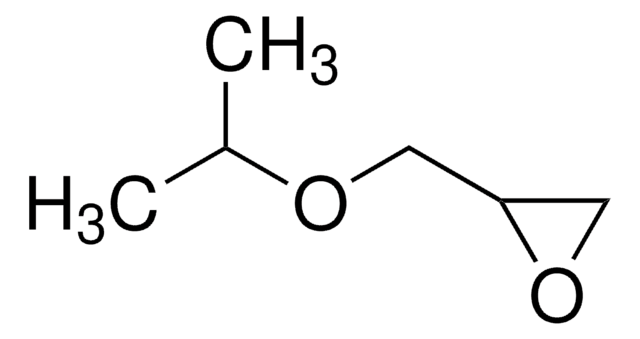Key Documents
251747
2-Ethylhexyl glycidyl ether
98%
Synonim(y):
2-Ethyl hexyleneglycidyl ether, 3-epoxypropane, Glycidyl 2-ethylhexyl ether
About This Item
Polecane produkty
Próba
98%
Postać
liquid
współczynnik refrakcji
n20/D 1.434 (lit.)
tw
60-62 °C/0.3 mmHg (lit.)
gęstość
0.891 g/mL at 25 °C (lit.)
ciąg SMILES
CCCCC(CC)COCC1CO1
InChI
1S/C11H22O2/c1-3-5-6-10(4-2)7-12-8-11-9-13-11/h10-11H,3-9H2,1-2H3
Klucz InChI
BBBUAWSVILPJLL-UHFFFAOYSA-N
Powiązane kategorie
Zastosowanie
- Solution properties of N-(2-allyl-butyl ether)-O-carboxymethyl chitosan and N-(2-allyl-isooctyl ether)-O-carboxymethyl chitosan.: This study explores the solution properties and potential applications of modified chitosan derivatives. It highlights their use in creating biocompatible coatings and medical device adhesives due to their enhanced solubility and functional properties (Liu et al., 2021).
- All-Polycarbonate Thermoplastic Elastomers Based on Triblock Copolymers Derived from Triethylborane-Mediated Sequential Copolymerization of CO(2) with Various Epoxides.: This research details the development of thermoplastic elastomers using 2-Ethylhexyl glycidyl ether as a monomer. These materials show promise in life science manufacturing for creating advanced epoxy systems and low viscosity epoxy resin modifiers (Jia et al., 2020).
- O-Carboxymethyl chitosan-based pH-responsive amphiphilic chitosan derivatives: Characterization, aggregation behavior, and application.: This paper discusses the creation of pH-responsive chitosan derivatives for use in biocompatible coatings and medical device adhesives. The modifications with 2-Ethylhexyl glycidyl ether improve their functionality and application potential in the medical field (Liu et al., 2020).
Hasło ostrzegawcze
Warning
Zwroty wskazujące rodzaj zagrożenia
Zwroty wskazujące środki ostrożności
Klasyfikacja zagrożeń
Skin Irrit. 2 - Skin Sens. 1
Kod klasy składowania
10 - Combustible liquids
Klasa zagrożenia wodnego (WGK)
WGK 2
Temperatura zapłonu (°F)
206.6 °F - closed cup
Temperatura zapłonu (°C)
97 °C - closed cup
Środki ochrony indywidualnej
Eyeshields, Gloves, type ABEK (EN14387) respirator filter
Wybierz jedną z najnowszych wersji:
Masz już ten produkt?
Dokumenty związane z niedawno zakupionymi produktami zostały zamieszczone w Bibliotece dokumentów.
Klienci oglądali również te produkty
Nasz zespół naukowców ma doświadczenie we wszystkich obszarach badań, w tym w naukach przyrodniczych, materiałoznawstwie, syntezie chemicznej, chromatografii, analityce i wielu innych dziedzinach.
Skontaktuj się z zespołem ds. pomocy technicznej










